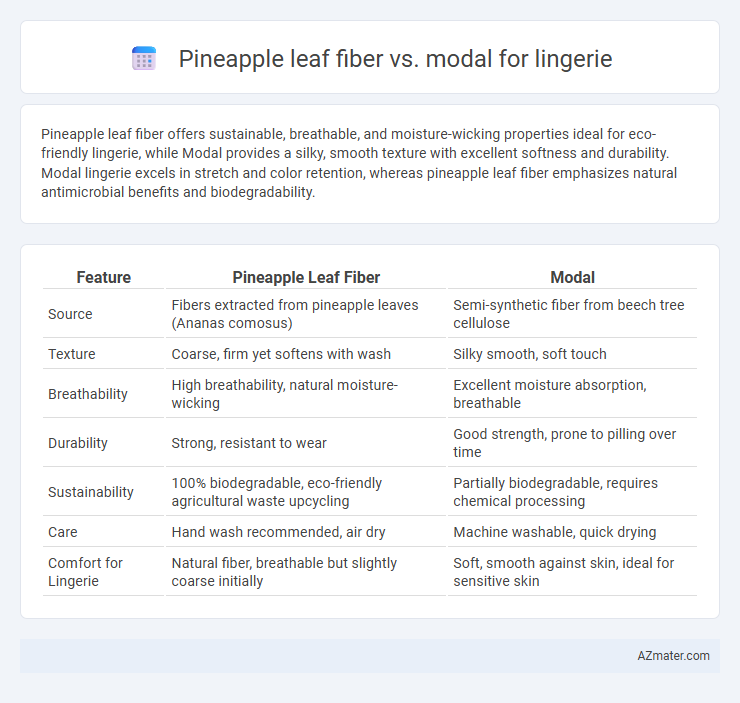Pineapple leaf fiber offers sustainable, breathable, and moisture-wicking properties ideal for eco-friendly lingerie, while Modal provides a silky, smooth texture with excellent softness and durability. Modal lingerie excels in stretch and color retention, whereas pineapple leaf fiber emphasizes natural antimicrobial benefits and biodegradability.
Table of Comparison
| Feature | Pineapple Leaf Fiber | Modal |
|---|---|---|
| Source | Fibers extracted from pineapple leaves (Ananas comosus) | Semi-synthetic fiber from beech tree cellulose |
| Texture | Coarse, firm yet softens with wash | Silky smooth, soft touch |
| Breathability | High breathability, natural moisture-wicking | Excellent moisture absorption, breathable |
| Durability | Strong, resistant to wear | Good strength, prone to pilling over time |
| Sustainability | 100% biodegradable, eco-friendly agricultural waste upcycling | Partially biodegradable, requires chemical processing |
| Care | Hand wash recommended, air dry | Machine washable, quick drying |
| Comfort for Lingerie | Natural fiber, breathable but slightly coarse initially | Soft, smooth against skin, ideal for sensitive skin |
Introduction to Sustainable Fibers in Lingerie
Pineapple leaf fiber, derived from agricultural waste, offers a biodegradable and eco-friendly alternative to conventional fibers, making it ideal for sustainable lingerie production. Modal, a semi-synthetic fiber made from beech tree pulp, is prized for its softness and moisture-wicking properties, aligning with eco-conscious lingerie brands seeking comfort and sustainability. Both fibers contribute significantly to reducing environmental impact through renewable sourcing and lower chemical usage compared to traditional synthetic materials.
What is Pineapple Leaf Fiber?
Pineapple leaf fiber (PALF) is a sustainable, natural textile derived from the leaves of pineapple plants, known for its strength, breathability, and eco-friendly production process. Unlike modal, which is a semi-synthetic fabric made from beech tree cellulose, PALF offers unique moisture-wicking properties and a coarse texture that softens with wear, making it suitable for breathable lingerie. Its biodegradable nature and minimal environmental impact make PALF a growing choice for eco-conscious lingerie brands seeking natural alternatives to conventional materials.
Understanding Modal: An Overview
Modal fibers, derived from beech tree cellulose, are highly regarded for their exceptional softness, breathability, and moisture-wicking properties, making them ideal for intimate apparel like lingerie. Pineapple leaf fiber, a natural byproduct from pineapple plants, offers sustainable strength and biodegradability but lacks the smooth, silky texture typical of modal fabrics. Understanding Modal's superior drape, durability, and skin-friendly characteristics highlights why it remains a preferred choice in luxury lingerie production.
Environmental Impact: Pineapple Leaf Fiber vs. Modal
Pineapple leaf fiber offers a sustainable alternative for lingerie production, derived from agricultural waste without requiring additional water or chemicals, significantly reducing environmental impact. Modal, a semi-synthetic fabric made from beech tree pulp, involves intensive chemical processing and higher water consumption despite its biodegradability. Choosing pineapple leaf fiber supports low-impact, eco-friendly lingerie manufacturing by minimizing deforestation and chemical pollution compared to modal fabric.
Comfort and Softness Comparison
Pineapple leaf fiber offers a naturally coarse texture that can be softened through processing but generally remains less smooth than Modal, which is known for its exceptional softness and silky feel, making it ideal for lingerie comfort. Modal fabric, derived from beech tree cellulose, provides superior breathability and elasticity, enhancing wearability and a gentle touch against sensitive skin, whereas pineapple leaf fiber is more sustainable but may require blending to achieve similar comfort levels. In terms of moisture-wicking and smoothness, Modal outperforms pineapple leaf fiber, providing an optimal balance of softness and durability crucial for intimate apparel.
Durability and Longevity in Lingerie Use
Pineapple leaf fiber offers exceptional durability and natural strength, making it highly resistant to wear and tear in lingerie use. Modal, a semi-synthetic cellulose fiber, provides softness and flexibility but tends to have less long-term resilience compared to pineapple leaf fiber. Lingerie made from pineapple leaf fiber maintains structural integrity and shape over prolonged use, contributing to extended longevity.
Breathability and Moisture Management
Pineapple leaf fiber exhibits excellent breathability due to its naturally porous structure, allowing air to circulate freely and keep the skin cool during wear. This fiber also demonstrates superior moisture management by efficiently wicking sweat away from the body, promoting quicker evaporation and dryness. In contrast, modal, a semi-synthetic fabric derived from beech tree pulp, offers good breathability but tends to retain more moisture, which can affect comfort during prolonged use.
Skin Sensitivity and Hypoallergenic Properties
Pineapple leaf fiber offers excellent hypoallergenic properties and is highly suitable for sensitive skin due to its natural antimicrobial and breathable qualities, reducing irritation and allergic reactions in lingerie. Modal, derived from beech trees, is also soft and breathable but may lack the same level of natural antimicrobial benefits, making it slightly less ideal for extremely sensitive skin. Choosing pineapple leaf fiber for lingerie provides a sustainable option with enhanced skin comfort and reduced risk of skin sensitivity issues.
Aesthetic Appeal and Design Potential
Pineapple leaf fiber offers a unique, natural texture and subtle sheen that enhances lingerie with an eco-friendly and artisanal aesthetic, appealing to sustainable fashion enthusiasts. Modal provides a smooth, silky finish that drapes elegantly, allowing for sleek, form-fitting designs with vibrant color retention and high breathability. Both fibers support innovative lingerie styles, but pineapple leaf fiber stands out for its organic, textured charm while modal excels in softness and fluidity.
Market Trends and Consumer Preferences
Pineapple leaf fiber is gaining traction in the lingerie market due to its sustainability and biodegradability, appealing to eco-conscious consumers seeking natural alternatives to synthetic fabrics. Modal remains popular for its softness, breathability, and moisture-wicking properties, driving demand in premium lingerie segments focused on comfort and performance. Market trends indicate a growing preference for blends that combine pineapple leaf fiber's eco-friendly benefits with Modal's luxurious feel, catering to ethical consumers without compromising on wearability.

Infographic: Pineapple leaf fiber vs Modal for Lingerie
 azmater.com
azmater.com